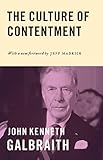The Culture of Contentment / John Kenneth Galbraith.
Material type: TextPublisher: Princeton, NJ : Princeton University Press, [2017]Copyright date: ©2017Description: 1 online resource (176 p.)Content type:
TextPublisher: Princeton, NJ : Princeton University Press, [2017]Copyright date: ©2017Description: 1 online resource (176 p.)Content type: - 9780691171654
- 9781400889020
- Free enterprise -- United States
- Free enterprise; United States
- Poor -- United States
- Poor; United States
- Social values
- BUSINESS & ECONOMICS / Economics / General
- Adam Smith
- Communism
- Contented Electoral Majority
- Contented Majority
- Democratic Party
- Eastern Europe
- Franklin D. Roosevelt
- New Deal
- Republican Party
- Ronald Reagan
- United States
- Western Europe
- acquisitions
- arms buildup
- bureaucracy
- bureaucratic syndrome
- capitalism
- common purpose
- communism
- complacency
- consumers
- contentment
- corporations
- costs
- crime
- defense spending
- democracy
- depression
- economic accommodation
- economic advantage
- economic discomfort
- economic life
- economic policies
- economic power
- economic well-being
- economically advantaged
- economics
- effective demand
- electoral politics
- external authority
- financial devastation
- fiscal policy
- foreign policy
- functional underclass
- government
- have nots
- haves
- immediate gratification
- immigrants
- incomes
- industrial economy
- inflation
- inner cities
- international relations
- laissez faire
- loan scandal
- macroeconomic policy
- macroeconomic regulation
- media
- mergers
- middle-class voting
- military action
- military power
- military spending
- military
- monetarism
- monetary policy
- money
- organization power
- political behavior
- political economy
- politics of contentment
- politics
- poor
- private sector
- public budget
- public expenditures
- public services
- purchasing power
- recession
- recreation
- regulation
- resentment
- savings scandal
- security
- self-regard
- social advantage
- social disorder
- social exclusion
- social unrest
- socially advantaged
- supply-side economics
- tax policy
- tax reductions
- taxation
- the poor
- thought
- time
- underclass revolt
- underclass
- urban slums
- violence
- war
- wealth
- welfare state
- well-being
- 306.30973 23
- HC106.8
- online - DeGruyter
- Issued also in print.
| Item type | Current library | Call number | URL | Status | Notes | Barcode | |
|---|---|---|---|---|---|---|---|
 eBook
eBook
|
Biblioteca "Angelicum" Pont. Univ. S.Tommaso d'Aquino Nuvola online | online - DeGruyter (Browse shelf(Opens below)) | Online access | Not for loan (Accesso limitato) | Accesso per gli utenti autorizzati / Access for authorized users | (dgr)9781400889020 |
Frontmatter -- CONTENTS -- FOREWORD -- A WORD OF THANKS -- CHAPTER 1. THE CULTURE OF CONTENTMENT -- CHAPTER 2. The Social Character of Contentment: An Overview -- CHAPTER 3. The Functional Underclass -- CHAPTER 4. Taxation and the Public Services: The Perverse Effect -- CHAPTER 5. The License for Financial Devastation -- CHAPTER 6. The Bureaucratic Syndrome -- CHAPTER 7. The Economic Accommodation, I -- CHAPTER 8. The Economic Accommodation, II -- CHAPTER 9. The Foreign Policy of Contentment: The Recreational and the Real -- CHAPTER 10. The Military Nexus, I -- CHAPTER 11. The Military Nexus, II -- CHAPTER 12. The Politics of Contentment -- CHAPTER 13. The Reckoning, I -- CHAPTER 14. The Reckoning, II -- CHAPTER 15. Requiem -- Index
restricted access online access with authorization star
http://purl.org/coar/access_right/c_16ec
The world has become increasingly separated into the haves and have-nots. In The Culture of Contentment, renowned economist John Kenneth Galbraith shows how a contented class-not the privileged few but the socially and economically advantaged majority-defend their comfortable status at a cost. Middle-class voting against regulation and increased taxation that would remedy pressing social ills has created a culture of immediate gratification, leading to complacency and hampering long-term progress. Only economic disaster, military action, or the eruption of an angry underclass seem capable of changing the status quo. A groundbreaking critique, The Culture of Contentment shows how the complacent majority captures the political process and determines economic policy.
Issued also in print.
Mode of access: Internet via World Wide Web.
In English.
Description based on online resource; title from PDF title page (publisher's Web site, viewed 30. Aug 2021)


